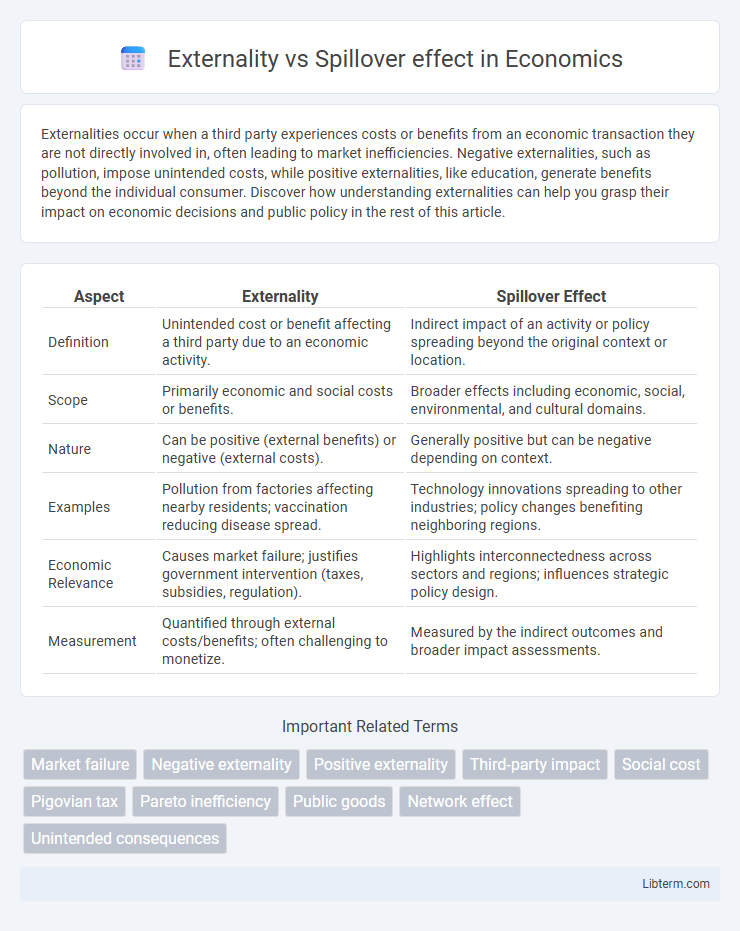Externalities occur when a third party experiences costs or benefits from an economic transaction they are not directly involved in, often leading to market inefficiencies. Negative externalities, such as pollution, impose unintended costs, while positive externalities, like education, generate benefits beyond the individual consumer. Discover how understanding externalities can help you grasp their impact on economic decisions and public policy in the rest of this article.
Table of Comparison
| Aspect | Externality | Spillover Effect |
|---|---|---|
| Definition | Unintended cost or benefit affecting a third party due to an economic activity. | Indirect impact of an activity or policy spreading beyond the original context or location. |
| Scope | Primarily economic and social costs or benefits. | Broader effects including economic, social, environmental, and cultural domains. |
| Nature | Can be positive (external benefits) or negative (external costs). | Generally positive but can be negative depending on context. |
| Examples | Pollution from factories affecting nearby residents; vaccination reducing disease spread. | Technology innovations spreading to other industries; policy changes benefiting neighboring regions. |
| Economic Relevance | Causes market failure; justifies government intervention (taxes, subsidies, regulation). | Highlights interconnectedness across sectors and regions; influences strategic policy design. |
| Measurement | Quantified through external costs/benefits; often challenging to monetize. | Measured by the indirect outcomes and broader impact assessments. |
Introduction to Externality and Spillover Effect
Externality refers to a cost or benefit incurred or received by a third party who is not directly involved in an economic transaction, impacting societal welfare beyond private market exchanges. Spillover effect denotes the broader consequences that economic activities have on unrelated areas or individuals, often extending beyond the original scope of impact. Understanding these concepts is crucial for analyzing market failures and designing policies to address unintended consequences in economics.
Defining Externalities: Key Concepts
Externalities refer to the unintended side effects of economic activities that affect third parties without being reflected in market prices. Positive externalities generate benefits, such as education improving public knowledge, while negative externalities impose costs, like pollution harming community health. Understanding these key concepts is essential for addressing market failures and designing effective regulatory policies.
Understanding Spillover Effects
Spillover effects refer to the unintended consequences of an economic activity that impact third parties who are not directly involved in the transaction. These effects can be positive, such as knowledge transfer between firms, or negative, like environmental pollution affecting nearby communities. Understanding spillover effects is crucial for designing policies that mitigate negative outcomes and enhance positive externalities in markets.
Types of Externalities: Positive and Negative
Positive externalities occur when a third party benefits from an economic transaction, such as education increasing overall societal knowledge or vaccines reducing disease spread. Negative externalities impose costs on unrelated parties, exemplified by pollution from factories harming nearby residents or noise from construction disturbing communities. Understanding these types of externalities helps in designing policies like taxes, subsidies, or regulations to mitigate negative impacts and promote positive spillover effects.
Types of Spillover Effects: Economic, Social, and Environmental
Spillover effects encompass economic, social, and environmental impacts extending beyond the initial activity or transaction, often resulting in externalities that affect third parties. Economic spillovers include technology diffusion and labor market impacts, social spillovers involve changes in community networks and social norms, while environmental spillovers relate to pollution and resource depletion affecting broader ecosystems. Recognizing these distinct types aids policymakers in designing targeted interventions to mitigate negative externalities and enhance positive spillovers for sustainable development.
Main Differences Between Externality and Spillover Effect
Externality refers to the direct impact of an economic activity on third parties without compensation, often classified as positive or negative based on its effects on social welfare. Spillover effect describes the broader, indirect consequences of an action or policy that extend beyond the immediate context, influencing unrelated sectors or regions. The main difference lies in externalities being specific unintended side effects within market transactions, while spillover effects encompass wider, sometimes intentional, influences across different areas or systems.
Real-World Examples of Externalities
Negative externalities like air pollution from factories impose health costs on nearby communities, while positive externalities such as vaccination programs reduce disease spread beyond vaccinated individuals, benefiting public health. Traffic congestion caused by individual drivers exemplifies a negative externality where each additional vehicle increases delays for others without compensation. Neighborhood improvements through well-maintained gardens create positive spillover effects by raising property values and enhancing overall community well-being.
Real-World Examples of Spillover Effects
Real-world examples of spillover effects include pollution from factories causing health issues in nearby communities, impacting public healthcare costs and local economies. Urban development projects often create positive spillovers by boosting local businesses and increasing property values in surrounding areas. Technology advancements in one company can lead to knowledge spillovers, benefiting competitors and fostering innovation across entire industries.
Policy Responses to Externalities and Spillover Effects
Policy responses to externalities and spillover effects typically involve government interventions such as taxes, subsidies, regulations, and tradable permits to correct market failures and align private incentives with social costs or benefits. Implementing Pigouvian taxes targets negative externalities by internalizing external costs, while subsidies encourage activities generating positive spillover effects. Regulatory measures enforce limits or standards, and market-based instruments like cap-and-trade systems create economic incentives to reduce harmful external impacts efficiently.
Conclusion: Comparing Externalities and Spillover Effects
Externalities and spillover effects both describe unintended consequences of economic activities affecting third parties, but externalities are a broader concept encompassing both positive and negative impacts, while spillover effects often specifically emphasize the transmission of these impacts across different sectors or regions. Externalities typically require intervention to correct market failures, as they lead to inefficiencies, whereas spillover effects highlight the interconnectedness of economic agents and the diffusion of benefits or costs beyond initial boundaries. Understanding the nuances between these terms aids in designing targeted policies that address specific external impacts while fostering beneficial spillovers for sustainable economic growth.
Externality Infographic

 libterm.com
libterm.com